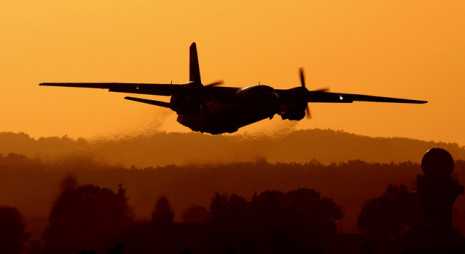Two Days, Two Aircraft, Six Seas
Szöveg: hungariandefence.com / mh59.hu | 2012. november 12. 9:58The members of the airlift squadron of the HDF 59th Szentgyörgyi Dezső Air Base were recently assigned an interesting mission: they were ordered to transport personnel and cargo to Northern Europe and South-Western Asia at the same time.

Carrying passengers and a cargo of supplies on board, the first aircraft left the HDF 59th Szentgyörgyi Dezső Air Base, Kecskemét for the Sinai Peninsula in Egypt the in the early morning hours on Sunday, October 4. A couple of hours later it reached Thessaloniki, and the Aegean Sea via the Bay of Thermae. After a short technical landing in Athens and flying across the Cyclades island group, it flew above the Sea of Crete and the Mediterranean Sea as far as Cyprus. Following a quick refueling and loading in Larnaka, the aircraft was back on its way to El Gorah, Egypt.
The airport (or better, a strip of tarmac) is famed for not being located in the area of a base but rather in open field, literally outside the fence, so Bedouin tribes driving their sheep sometimes set up their camp in its area. Here the aircraft crews are supposed to indicate their intention to land in advance, so that the MFO personnel can make the airfield suitable for safe landing by the time of arrival.

Next day the crewmembers continued the flight. They flew along the Israeli border as far as Taba, from where they got, via the Gulf of Aqaba, to the Red Sea, the southernmost point of their travel, Sharm el-Sheik.
The second plane would have left Hungary early Monday morning to transport a working group to the Kingdom of Sweden where they were to take over the Gripen fighters after the periodical maintenance was finished, but the winter weather that set in so early forced the crew to take off with a slight delay. Due to the heavy snowfall, the aircraft needed de-icing, and the crew had to wait until visibility reached at least the minimum required level for take-off at the Kecskemét air base.
After the successful take-off, they started heading north and three hours later reached the Baltic Sea by Poland. Flying above Ronne Island, which belongs to the Kingdom of Denmark, they entered the airspace of Sweden, then after an hour they reached the first stop on their route, the air base in Satenas next to Vänern Lake. After loading and refueling, they left this base for the United Kingdom in order to complete the second part of their mission, during which they transported helicopter pilots and technicians to York for a course. Shortly after take-off, they were flying above the Kingdom of Norway, where the ACC gave them permission for a direct approach to NIVUM, the entry point in Great Britain, which is already on the North Sea.

The interesting thing about flying above the North Sea is that the signals of conventional navigational aids (VOR, DME, NDB) are unavailable due to the great distances, so on these occasions the GPS and the means of elementary navigation are to be used together in a complex way. Flying in a strong headwind, the second plane reached the British Isles by the coast of South Scotland, and landed at the RAF airfield Linton-on-Ouse in an hour.
The mission for the aircraft of the Airlift Squadron did not end here, so by Wednesday the first and second planes successfully returned to Kecskemét on a route similar to the outbound one. The two An-26s completed their assigned airlift missions in two days, flying over six seas en route.